
Welcome to annarborsnakes.com! I am David, a snake enthusiast living in Ann Arbor, MI. Many people don't know that Ann Arbor is in fact full of snakes! You just need to know where to find them - they can often be shy and elusive. Some Michigan snake species are more common outside of the city limits, in different parts of Washtenaw County MI, but many types of snakes are indeed common in the more urban parts of Ann Arbor. This guide is meant to help educate you about the beautiful snakes of Ann Arbor, and to help you identify the most common snakes of Ann Arbor, as well as the venomous snakes of Ann Arbor that you should learn to recognize and avoid. If you want more detail, click here for my complete list of ALL snake species in Ann Arbor. Remember the following:
- Most snakes of Ann Arbor are harmless and don't want to encounter you
- Venomous snakes exist but are uncommon in Ann Arbor, Michigan
- Snakes eat rats and mice and are a valuable part of the Michigan ecosystem
- Never kill a snake - if you leave a snake alone, it will leave you alone.
Common Snake Species in Ann Arbor
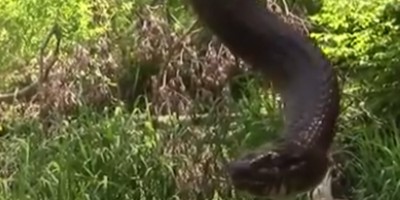 Northern water snake:
This is a moderately large non-venomous water snake that looks somewhat like the venomous cottonmouth. The northern water snake sports tan, gray, or dark brown skin with black or reddish-brown cross-bands and splotches across its back. These snakes will grow to about 48 inches long and will often be seen basking around water bodies and wetlands. They are non-venomous but will bite if threatened.
Northern water snake:
This is a moderately large non-venomous water snake that looks somewhat like the venomous cottonmouth. The northern water snake sports tan, gray, or dark brown skin with black or reddish-brown cross-bands and splotches across its back. These snakes will grow to about 48 inches long and will often be seen basking around water bodies and wetlands. They are non-venomous but will bite if threatened. 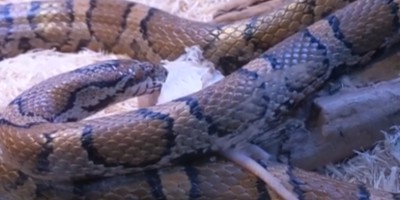 Eastern milk snake:
These snakes can be light gray or tan with rows of black-edged reddish-brown splotches across their backs. They are non-venomous and sometimes mistaken for the venomous copperhead. Eastern milk snakes can be found in different habitats throughout the state including marshes, farmlands, barns, gardens, and buildings. These mid-sized snakes will measure between 28 and 52 inches in length.
Eastern milk snake:
These snakes can be light gray or tan with rows of black-edged reddish-brown splotches across their backs. They are non-venomous and sometimes mistaken for the venomous copperhead. Eastern milk snakes can be found in different habitats throughout the state including marshes, farmlands, barns, gardens, and buildings. These mid-sized snakes will measure between 28 and 52 inches in length.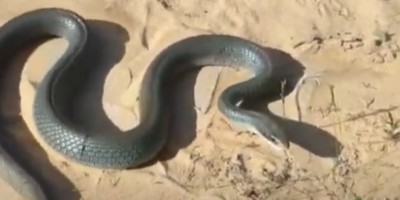 Blue racer:
This is a bluish-gray medium-sized snake with a fairly slender body found mostly in open forests, old fields, hedgerows, grassy lake edges, thickets, and marshes. These snakes are solid colored and sometimes appear gray, olive, or brown, and they measure from 35 to 75 inches in length.
Blue racer:
This is a bluish-gray medium-sized snake with a fairly slender body found mostly in open forests, old fields, hedgerows, grassy lake edges, thickets, and marshes. These snakes are solid colored and sometimes appear gray, olive, or brown, and they measure from 35 to 75 inches in length.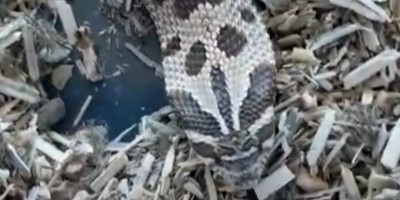 Eastern hog-nosed snake:
Eastern hog-nosed snakes are mostly found in sandy woodlands, old fields, open forests, and other terrestrial habitats. These snakes are typically about 20 to 40 inches long with varied coloration; base color can be gray, tan, olive, yellow, brown, or orange with irregular patterns of dark blotches and spots along their bodies. The upturned snout of the hog-nosed snake is its major distinctive feature.
Eastern hog-nosed snake:
Eastern hog-nosed snakes are mostly found in sandy woodlands, old fields, open forests, and other terrestrial habitats. These snakes are typically about 20 to 40 inches long with varied coloration; base color can be gray, tan, olive, yellow, brown, or orange with irregular patterns of dark blotches and spots along their bodies. The upturned snout of the hog-nosed snake is its major distinctive feature.
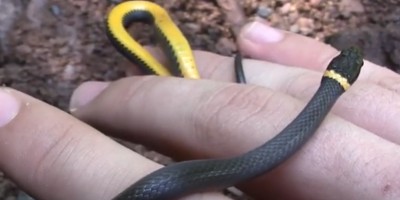 Ring-necked snake:
This is a small solid black, gray, or brown snake with an orange or yellowish ring around its neck. Adult ring-necked snakes are about 11 to 25 inches long and are usually found hiding beneath leaf piles, logs, or debris in open forests, woodlands, trash dumps, or grassy dunes. These snakes have slightly venomous saliva, but they are considered non-venomous because they cause no real harm to humans.
Ring-necked snake:
This is a small solid black, gray, or brown snake with an orange or yellowish ring around its neck. Adult ring-necked snakes are about 11 to 25 inches long and are usually found hiding beneath leaf piles, logs, or debris in open forests, woodlands, trash dumps, or grassy dunes. These snakes have slightly venomous saliva, but they are considered non-venomous because they cause no real harm to humans.
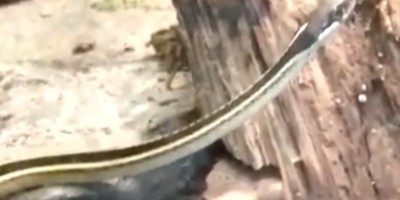 Northern ribbon snake:
Commonly found in wetlands, these snakes are closely related to garter snakes and look very much alike. Ribbon snakes are slender and usually measure from 18 to 38 inches, they are mostly brown with yellow stripes running along their bodies. These snakes are excellent swimmers and are found in abundance in aquatic habitats.
Northern ribbon snake:
Commonly found in wetlands, these snakes are closely related to garter snakes and look very much alike. Ribbon snakes are slender and usually measure from 18 to 38 inches, they are mostly brown with yellow stripes running along their bodies. These snakes are excellent swimmers and are found in abundance in aquatic habitats.
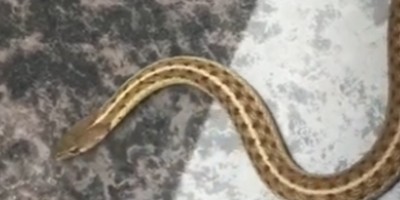 Butler's garter snake:
This is a very common snake in Michigan, and they are found in many different habitats; meadows, marshes, grasslands, ponds, and lake edges. Measuring 15 to 27 inches, their small stout bodies are usually black, brown, or olive with bright yellow or orange stripes. Adult males are much smaller and slimmer than females.
Butler's garter snake:
This is a very common snake in Michigan, and they are found in many different habitats; meadows, marshes, grasslands, ponds, and lake edges. Measuring 15 to 27 inches, their small stout bodies are usually black, brown, or olive with bright yellow or orange stripes. Adult males are much smaller and slimmer than females.
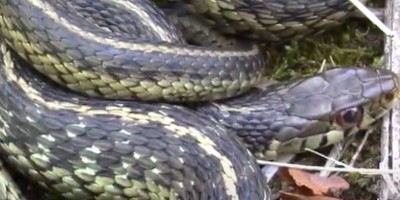 Eastern garter snake:
Eastern garter snakes are generally common and appear in a wide range of habitats throughout the state of Michigan. Like their cousins, Butler garter snakes, they have black, gray, or olive base color with bright yellow, green, or white stripes along the length of their bodies, and they vary widely in length from 18 to 26 inches, some have been known to reach 50 inches. Eastern garter snakes are found in wetlands, ponds, streams, and grasslands.
Eastern garter snake:
Eastern garter snakes are generally common and appear in a wide range of habitats throughout the state of Michigan. Like their cousins, Butler garter snakes, they have black, gray, or olive base color with bright yellow, green, or white stripes along the length of their bodies, and they vary widely in length from 18 to 26 inches, some have been known to reach 50 inches. Eastern garter snakes are found in wetlands, ponds, streams, and grasslands.
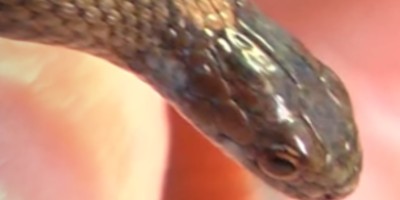 Red-bellied snake:
Found throughout Michigan in fields and woods, these snakes are small with black, gray, or brown bodies with faint stripes and bright yellow or orange bellies. They usually hide beneath piles of rubbish or objects in trash dumps and will range from 8 to 16 inches in length.
Red-bellied snake:
Found throughout Michigan in fields and woods, these snakes are small with black, gray, or brown bodies with faint stripes and bright yellow or orange bellies. They usually hide beneath piles of rubbish or objects in trash dumps and will range from 8 to 16 inches in length.
 Brown snake:
These are small brown, tan, or gray colored snakes with a pale brown central stripe bordered by a row of dark spots on each side. These snakes are usually between 8 and 15 inches long and are found in marshes and meadows, and sometimes in suburbs.
Brown snake:
These are small brown, tan, or gray colored snakes with a pale brown central stripe bordered by a row of dark spots on each side. These snakes are usually between 8 and 15 inches long and are found in marshes and meadows, and sometimes in suburbs.Venomous Snake Species in Ann Arbor
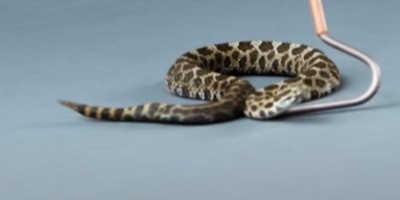 Eastern massasauga rattlesnake:
The eastern massasauga rattlesnake is the only venomous snake native to Michigan. These snakes reside mainly in wetlands and swamps, they are not very common and sightings are very rare. The massasauga rattler is usually between 18 and 30 inches long and is typically black, brown, or tan with rows of small dark spots along each side. They are the smallest rattlesnakes in the US, they actively avoid humans and will rattle and bite when threatened.
Eastern massasauga rattlesnake:
The eastern massasauga rattlesnake is the only venomous snake native to Michigan. These snakes reside mainly in wetlands and swamps, they are not very common and sightings are very rare. The massasauga rattler is usually between 18 and 30 inches long and is typically black, brown, or tan with rows of small dark spots along each side. They are the smallest rattlesnakes in the US, they actively avoid humans and will rattle and bite when threatened.
If you're unsure, you can email me a photo of the snake at info@annarborsnakes.com and I will email you back with the snake's species. If you found a snake skin, read my Found a Skin? page, and you can email me a photo of the skin, and I'll identify the snake for you. If you need professional Ann Arbor snake removal help, click my Get Help page, or see the below website sponsor I found, who provides that service.
Remember, the term is not poisonous snakes of Ann Arbor, it's venomous snakes of Ann Arbor. Poison is generally something you eat, and venom is injected into you. That said, dangerous snakes are very rare in Ann Arbor. The few venomous snakes of Washtenaw County are rarely seen. But they are commonly misidentified, so learn about all the snake species of Ann Arbor in order to correctly identify them. These snakes are usually also found in the surrounding towns of Ypsilanti, Saline, Dexter, Chelsea, Manchester, Pittsfield Charter Township, Ypsilanti Charter Township, Superior Charter Township, Ann Arbor Charter Township, York charter Township, and the surrounding areas.
Read our article about:
What Can I Use To Catch A Snake?
annarborsnakes.com domain and hosting costs made possible by the generous support of this sponsor:
